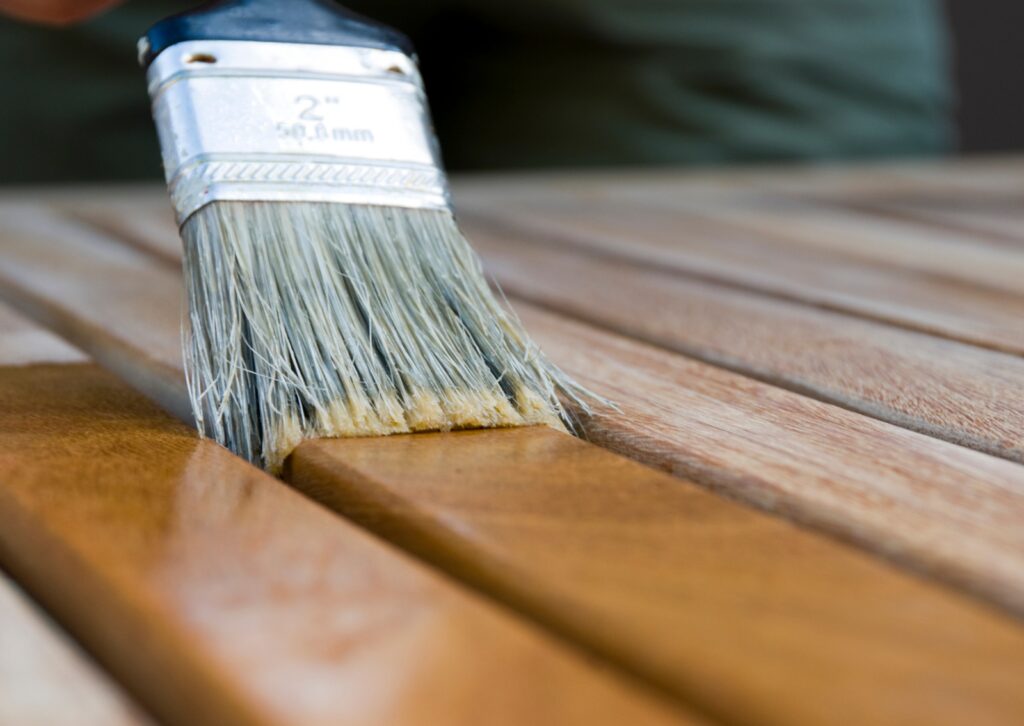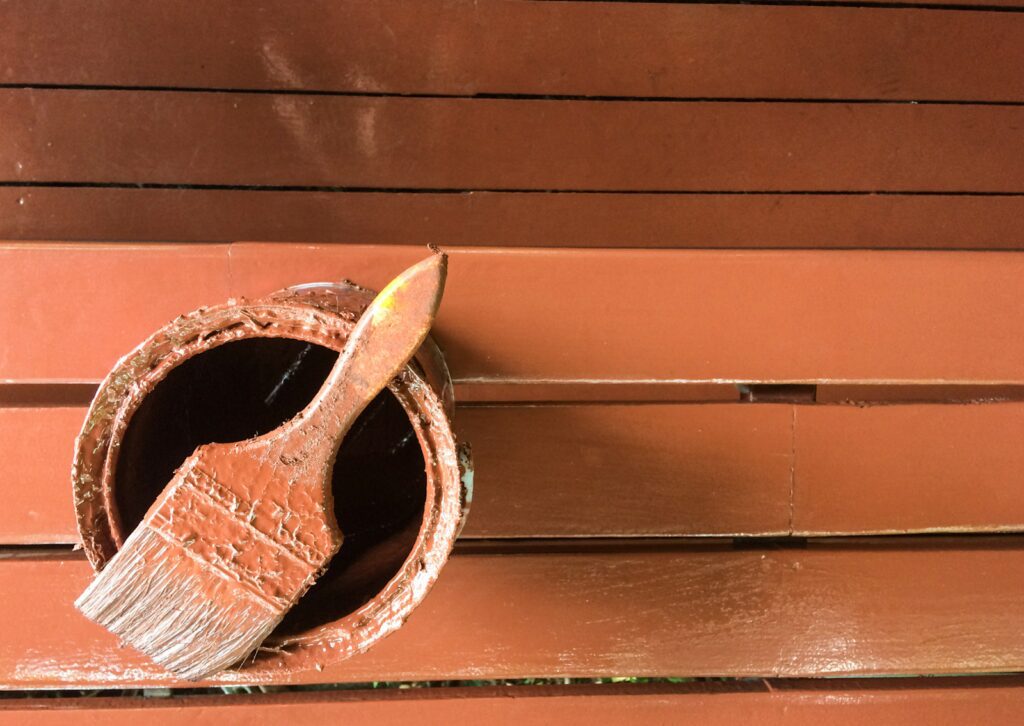
When it comes to giving your wood furniture a makeover or tackling a major wood painting project, choosing the best wood paint is crucial. Whether you’re working on indoor furniture, outdoor furniture, or large exterior surfaces, the right paint can significantly impact the outcome of your project. From chalk paint to oil-based paints and even spray paint, knowing the best options available will help you achieve that professional finish you’re aiming for. Not all paint is created equal, especially when it comes to painting wood, so it’s essential to choose a product specifically designed for wooden surfaces. Additionally, considering factors like durability and finish can help ensure your furniture project stands the test of time.
Let’s dive into the world of wood paints, discussing everything from prep work to choosing the right paint sheen, and offer expert tips for achieving long-lasting, flawless results.
Types of Wood Paint: Choosing the Right Option for Your Project

When selecting the best wood paint, it’s essential to consider the type of wood and the environment in which the furniture or structure will be located. There are a variety of paints you can choose from:
Oil-Based vs. Water-Based Paints
One of the first choices you’ll have to make is between oil-based paint and water-based paint. Oil-based paints are known for their durable finish and are often chosen for outdoor furniture because they can withstand harsh weather conditions. However, water-based latex paint is much easier to clean, dries faster, and is a great option for indoor furniture and projects that don’t require such heavy-duty protection. Acrylic paint, a type of water-based paint, is also an excellent choice for furniture projects due to its versatility and quick-drying properties. When choosing between oil-based and water-based paints, consider the project’s location and the level of durability required.
Chalk Paint vs. Latex Paint
Another comparison worth noting is chalk paint versus latex paint. Chalk paint is known for its velvety, matte finish, making it perfect for wood furniture and wood crafts that require a vintage look. Latex paint, on the other hand, provides more versatility for both interior and exterior surfaces with options like semi-gloss and high gloss finishes, making it a great all-around choice. Milk Paint is another popular option that offers a durable, low-luster finish ideal for furniture and cabinetry. This type of paint combines the best qualities of both chalk and latex paints, providing excellent adhesion and a smooth finish.
Best Wood Paint for Indoor Furniture

If you’re working on indoor furniture, the best paint for wood will likely be water-based latex paint or chalk paint, depending on the finish you’re looking for. Chalk paint is excellent for that smooth, rustic look, while latex paint provides a more modern, durable look that can resist wear and tear over time. Alkyd paint is another option worth considering for indoor use, as it offers the durability of oil-based paints with lower VOCs and easier cleanup. When selecting paint for indoor furniture, consider factors such as ease of application, drying time, and the desired finish to achieve the best results for your project.
Smooth Finish with Satin or Semi-Gloss Paints
For a smooth finish on wooden surfaces, consider using satin paint or semi-gloss. These sheets are great for furniture because they offer a subtle shine while also being easy to clean, perfect for high-traffic areas or frequently used furniture like chairs or tables. Paint sheens play a crucial role in the final appearance and durability of your painted surface. A satin finish provides a happy medium between matte and glossy, offering a soft luster that’s perfect for many furniture pieces. For a more pronounced sheen, semi-gloss can add depth and richness to your painted wood.
Handling Brush Strokes for a Professional Look
Avoiding visible brush strokes is a common challenge when painting wood. One way to reduce the appearance of brush strokes is by thinning your paint slightly and using a high-quality brush. Additionally, working with a paint sprayer can help you achieve a smoother, more even coat. Some durable paints are self-leveling, which means they smooth out as they dry, minimizing brush strokes. When applying paint, use long, smooth strokes and avoid overworking the surface to achieve a professional-looking finish.
Best Paint for Outdoor Wooden Surfaces

When painting outdoor furniture or large exterior surfaces, durability is key. The best paint for wood in these conditions will usually be an oil-based paint or exterior latex paint, both of which can handle moisture, UV rays, and temperature changes without cracking or peeling. Durable paint formulations specifically designed for exterior use often contain additives that protect against fading, mildew, and other outdoor challenges. When choosing paint for outdoor projects, look for products that offer UV resistance and waterproofing properties to ensure long-lasting results.
Exterior Latex Paint for Durability
Exterior latex paint is a great choice for outdoor furniture and surfaces like decks and fences. It offers a durable finish that can handle weather fluctuations while being easy to apply and clean. Plus, it dries much faster than oil-based paints, making it a more convenient choice for quick projects. Many exterior latex paints are formulated with advanced color pigments that resist fading, ensuring your outdoor furniture maintains its vibrant appearance for years to come. When selecting exterior paint, consider the specific requirements of your wood project and choose a product that offers the right balance of durability and aesthetics.
Choosing a Paint Finish for Exterior Surfaces
For exterior surfaces, you’ll want to choose the right sheen to protect your wood. A high gloss finish can help repel dirt and moisture, making it a great choice for outdoor furniture. For a more subtle look, a matte finish can work as well but may require more maintenance. The choice between a glossy finish, matt finish, or flat finish depends on the desired appearance and the level of protection needed for your outdoor wooden surfaces. Consider factors such as exposure to sunlight, moisture, and wear when selecting the appropriate paint sheen for your exterior wood projects.
The Importance of Prep Work Before Painting Wood

Before you start painting, prep work is essential. Proper preparation ensures that your paint job will last and that the paint will adhere smoothly to the surface. Raw wood often requires additional preparation to ensure optimal paint adhesion and a smooth finish. Taking the time to properly prepare your wood surface will significantly impact the quality and longevity of your paint job.
Sanding and Smoothing Wood Surfaces
Sanding is an important step to achieve a smooth finish. Using fine-grit sandpaper, lightly sand the surface to remove any rough spots or old paint. This ensures that the new paint will bond properly to the wood surface. Light sanding between coats can also help achieve an ultra-smooth finish, especially when working with oil-based or enamel paints. Remember to remove all dust thoroughly after sanding to ensure proper paint adhesion.
Using Wood Filler for Imperfections
If your wood has imperfections such as cracks or holes, using a wood filler will help create a smooth, even surface. Be sure to let the filler dry completely before sanding it down to ensure a flawless paint finish. For larger imperfections, you may need to apply multiple layers of wood filler, allowing each layer to dry completely before adding the next. This attention to detail in the preparation stage will result in a more professional-looking final product.
Painting Techniques for Achieving a Flawless Finish

Applying the paint in thin, even coats is the key to achieving a flawless finish. Depending on the type of paint you choose, you may need two to three coats to get the desired look. Some types of paint may allow you to paint directly onto the wood without a primer, but in most cases, using a primer can improve adhesion and color vibrancy. When applying multiple coats, allow each layer to dry completely before adding the second coat to ensure the best possible finish.
The Importance of Applying a Top Coat
A top coat is crucial for protecting your painted wood from scratches, moisture, and UV damage. Oil-based top coats are highly durable and are best for outdoor furniture, while water-based top coats work well for indoor projects. Applying a clear top coat can enhance the durability of your paint job and make it easier to clean and maintain. Some of the best paints for wood incorporate protective properties, but an additional top coat can provide extra insurance against wear and tear.
Layering Coats for Maximum Durability
For best results, always allow each coat of paint to dry fully before applying the next. This ensures that the paint doesn’t peel or bubble, and it helps create a durable finish that will last for years. The number of coats you apply can significantly impact the durability and appearance of your painted wood. In general, two to three coats of paint, followed by a protective top coat, will provide the best results for most wood projects.
Best Practices for Painting Wood Furniture

When painting furniture, it’s important to follow certain best practices, especially when working on delicate or antique pieces. Furniture paint that’s designed specifically for wood projects can offer a durable finish without damaging the underlying material. Milk paint is an excellent option for achieving a vintage look on furniture, while modern acrylic-based paints can provide a more contemporary finish. Consider the style and intended use of the furniture when selecting the appropriate paint and finish.
Using Spray Paint for a Quick and Even Finish

For certain wood projects, especially smaller items, spray paint can provide a quick, even finish with minimal brush strokes. Just be sure to use a paint sprayer that is suitable for wood surfaces, and always apply in thin, even layers to avoid drips. Spray paint can be particularly useful for intricate or hard-to-reach areas of furniture. However, be aware that some spray paints may have a strong odor, so ensure proper ventilation when using them, especially for indoor use.
Oil-Based Paint: The Traditional Choice for Wood Projects

While newer paints like latex paint and chalk paint have their advantages, oil-based paint remains a popular choice for wood projects that need to stand up to heavy wear and tear. It provides a durable finish and can be used for both indoor and outdoor applications. Oil-based paints often require longer drying times between coats, but they offer excellent coverage and a smooth finish. When using oil-based paints, be prepared for a longer project timeline and ensure proper ventilation due to their strong odor.
Choosing the Right Sheen: Matte, Glossy, or Satin

One of the final decisions you’ll need to make is choosing the right paint sheen for your project. Matte finishes offer a more rustic look, while glossy finishes are perfect for areas that need to repel moisture or dirt. Paint sheens not only affect the appearance of your painted wood but also impact its practicality. For example, a glossy finish is easier to clean but may highlight imperfections, while a flat finish can hide flaws but may be more challenging to maintain. Consider the function and location of your painted wood when selecting the appropriate sheen.
Painting Crown Molding and Trim: Special Considerations

When painting crown molding and trim, you’ll need to pay extra attention to detail, as these areas often have intricate designs. These architectural elements can significantly enhance the overall appearance of a room, so choosing the right paint and application technique is crucial. Consider using specialized trim paint that is formulated to provide excellent coverage and a durable finish on these high-impact areas.
Choosing the Right Paint Sheen for Trim Work
For trim work, a semi-gloss or high-gloss finish is typically recommended. These finishes are easy to clean and resistant to scuff marks, making them ideal for high-traffic areas. The higher sheen also helps to highlight the decorative aspects of crown molding and trim, adding depth and visual interest to your space. When selecting paint for trim, look for products that offer good flow and leveling properties to achieve a smooth, professional-looking finish.
Ensuring a Smooth Finish on Delicate Surfaces
Applying thin, even coats and allowing for full drying between layers will help you achieve a smoother finish on crown molding and trim. When working with intricate details, consider using a small brush or foam applicator to ensure even coverage in tight spaces. Some painters prefer to use a paint sprayer for trim work, as it can provide a very smooth finish without brush marks. Whichever method you choose, take your time and pay close attention to detail for the best results.
Common Mistakes to Avoid When Painting Wood

Avoiding common mistakes, such as skipping prep work or choosing the wrong type of paint, will help you achieve a professional-looking paint job. Always test your paint on a small, inconspicuous area before committing to a large project. One common mistake is rushing the process – remember that proper drying time between coats is crucial for a durable finish. Another pitfall to avoid is using the wrong type of brush for your chosen paint, as this can result in visible brush strokes or an uneven application.
Caring for Painted Wood Surfaces After the Job

Once your paint job is complete, it’s important to properly care for your painted wood to ensure it lasts as long as possible. Regular maintenance can significantly extend the life of your paint job and keep your wooden surfaces looking fresh and vibrant. Develop a care routine that includes gentle cleaning and periodic inspections to catch any issues early.
Cleaning and Dusting Painted Wood Furniture
Use a soft cloth and gentle cleaner to dust and clean your painted wood surfaces without damaging the finish. Avoid using harsh chemicals or abrasive cleaning tools that could scratch or dull the paint. For routine cleaning, a slightly damp microfiber cloth is often sufficient to remove dust and light dirt. For more stubborn marks, use a mild soap solution, and be sure to dry the surface thoroughly after cleaning.
Touch-Up Techniques for Scratches and Chips
For small scratches and chips, use a small brush to touch up areas with leftover paint. Be sure to apply in thin layers for a smooth finish. Keep some of your original paint on hand for future touch-ups, as it can be challenging to match the exact color and sheen later. For larger damaged areas, you may need to sand the area lightly, apply a primer, and then repaint the entire surface for a seamless repair.
How Extreme Temperatures Can Affect Wood Paint

Be mindful of extreme temperatures when painting wood surfaces, as they can affect how the paint adheres and dries. For best results, paint when the weather is mild to avoid cracks or peeling later. Temperature fluctuations can cause wood to expand and contract, which may lead to paint cracking or peeling over time. When painting outdoor furniture or structures, choose paints specifically formulated to withstand temperature variations and other environmental factors.
Choose the Right Paint and Start Your Wood Painting Project Today!

Ready to give your wood furniture or outdoor structures a fresh look? Choosing the best wood paint is the first step toward achieving a stunning, professional finish. Whether you opt for chalk paint, oil-based paints, or water-based latex paint, your project will shine with the right prep work and application techniques. Remember that the success of your paint job depends not only on the quality of the paint but also on proper preparation and application techniques. Take the time to research and select the best paint for your specific wood project to ensure long-lasting, beautiful results.
If you’re looking for a professional touch to ensure your wood painting project achieves flawless results, M&E Painting and Roofing offers expert services for both residential and commercial projects. Whether it’s giving your furniture a fresh new look or painting large exterior surfaces, their experienced team handles every project with precision and care. With a reputation for delivering high-quality, durable finishes, M&E Painting and Roofing is the go-to choice for homeowners and business owners alike. Let their skilled professionals save you time and effort while providing exceptional results that stand the test of time. Contact M&E Painting and Roofing today for all your painting needs, and enjoy the peace of mind that comes with a job well done.
If you’re looking for expert advice or professional painting services, don’t hesitate to reach out to M&E Painting and Roofing. Their experienced team can handle any project, big or small, ensuring that your home or furniture gets the attention and care it deserves.We hope this guide helps you confidently choose the best paint for wood and achieve that professional finish you’re aiming for. While DIY can be a great option, it’s always best to opt for professional service to avoid potential issues and ensure the best results. Whether it’s selecting the right wood paint or applying the perfect top coat, following these tips will ensure a long-lasting, flawless result. For any painting project where you need expert assistance, you can count on M&E Painting and Roofing to deliver exceptional service and stunning results. Let their professional team handle your next project for a beautiful, durable finish. Happy painting!
